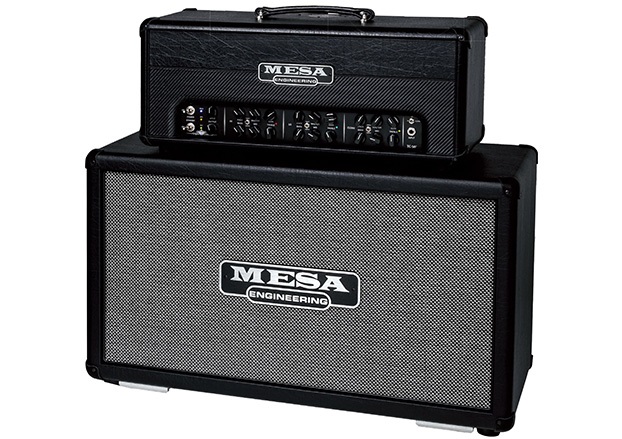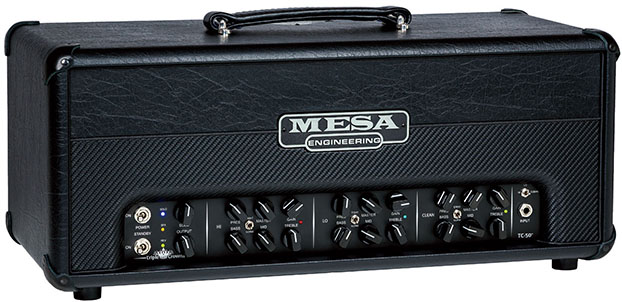Review: Mesa Triple Crown TC-50 Guitar Amp

Mesa Engineering is rightfully known for pioneering the modern high-gain guitar amp as well as for their incredibly versatile Mark Series amps, which offer guitarists a staggering variety of tones and sound-shaping options.
However, I personally think Mesa’s more streamlined amps are worthy of similar acclaim, especially when it comes to their rock- and metal-voiced amps like the Dual and Triple Rectifier models as well as the under-appreciated Caliber Series.
Mesa’s new Triple Crown Series seems to spring from a similar streamlined-yet-versatile mindset, delivering awesome rock and metal tones but also offering some of the best clean tones in the industry. The TC-50 is currently Mesa’s only Triple Crown model, available in head only, rack mount head or 1x12 combo formats. We auditioned the TC-50 head with a Mesa 2x12 Compact Rectifier cabinet loaded with Celestion Vintage 30 speakers.
FEATURES
As you might have guessed from the Triple Crown TC-50’s name, this is a three-channel 50-watt amp with fully independent Clean, Lo-Gain and Hi-Gain channels, each with its own set of gain, treble, mid, bass, presence and master controls on the front panel and independent reverb controls on the rear panel. Each channel also features a mini toggle switch for choosing drive/normal modes (clean channel only) or tight/normal modes (lo-gain and high-gain channels) that let you further sculpt and customize each channel’s character.
Other front-panel controls include a Solo (boost level) knob, master output level knob and toggle switch for manually selecting channels.

The rear panel is generously appointed with a wide variety of professional features that allow further customization for performance and studio applications. The Bias Select switch features two settings (EL34/6V6 and 6L6) that allows users to swap power tubes to modify the amp’s tonal and dynamic character (the amp ships with EL34 tubes).
Switches for the Solo, Reverb and EFX Loop allow users to keep each function permanently on or use the included six-switch footswitch to turn each on and off individually (the other three footswitches are for channel selection). The CabClone D.I. cabinet simulation circuitry includes a speaker on/off switch (for direct recording without a speaker cab or external load box), a switch for selecting closed-back, open-back or vintage cabinet styles and a balanced XLR CabClone D.I. output.
Get The Pick Newsletter
All the latest guitar news, interviews, lessons, reviews, deals and more, direct to your inbox!
The cabinet style settings also influence the sound sent to the ¼-inch headphone output. Other rear-panel features include ¼-inch EFX loop send and return jacks, two ¼-inch speaker output jacks with 4/8- ohm impedance switch, ¼-inch line output, XLR lift/ground switch, 6-pin DIN footswitch jack, MIDI In and Out/Thru DIN jacks, MIDI channel select switch and Store switch for saving amp settings to MIDI program change numbers or performing SysEx load and dump functions.
In addition to the two EL34 power tubes, the TC-50’s circuit features six 12AX7 and one 12AT7 to drive the preamp section. The overall construction and transformers are certainly heavy duty, but thanks to its compact configuration, the amp weighs in at a manageable 35 pounds.
PERFORMANCE
While the Triple Crown may not offer all of the intricate tone-sculpting features of Mesa’s flagship Mark Five model, most players will find the TC-50’s versatility similarly compelling. From crisp, ethereal clean tones to incredibly heavy, dark and doom-laden high-gain distortion, this amp truly does it all and hits all of the desirable destinations in between.
The clean channel delivers sharp, percussive spank that goes from crystal clean to overdrive crunch, while the lo-gain channel covers a delicious range of distortion tones from tweed-like grind to British crushed-glass explosiveness. The hi-gain channel is awesome for super-smooth compressed solo tones or dense metal rhythm tones with harmonically complex, impressively defined attack and clarity. The spring reverb tank may be rather compact, but it produces some of the smoothest and sweetest reverb I’ve ever heard from an analog spring unit, outshining reverb tanks more than twice its size.
The power-tube-swapping capability, CabClone D.I. section and sophisticated MIDI capabilities are all worth their own reviews, but in this short space I’ll just say they work very well and are very easy to use. Personally, I found that the included EL34 tubes worked best for the kind of sounds I like (open, airy cleans, harmonically complex, aggressive distortion with smooth compression, etc.), although 6L6 tubes sound pretty damn good too with more clean headroom and tighter attack.
STREET PRICE: $1,799
MANUFACTURER: Mesa Engineering, mesaboogie.com
● A 50-watt amp driven by two EL34 power tubes, six 12AX7 and one 12AT7 tubes for the preamp section and a silicon rectifier.
● Each of the three channels (clean, lo-gain, hi-gain) features a mode switch for customizing the midrange character of each channel individually.
● The CabClone D.I. section allows guitarists to record the amp direct using built-in speaker simulation without having the amp connected to a speaker cabinet.
● The included six-switch footswitch controls channel, reverb, EFX loop and Solo (boost) switching, or more sophisticated switching can be performed via MIDI.
THE BOTTOM LINE
If you want it all, from stellar clean tones to vicious modern metal distortion, but prefer simple, easy-to-use controls that don’t require an engineering degree to figure out, the Mesa Triple Crown TC-50 is a real winner with a thoroughbred pedigree when it comes to first-class tone.
Chris is the co-author of Eruption - Conversations with Eddie Van Halen. He is a 40-year music industry veteran who started at Boardwalk Entertainment (Joan Jett, Night Ranger) and Roland US before becoming a guitar journalist in 1991. He has interviewed more than 600 artists, written more than 1,400 product reviews and contributed to Jeff Beck’s Beck 01: Hot Rods and Rock & Roll and Eric Clapton’s Six String Stories.
“If you’ve ever wondered what unobtanium looks like in amp form, this is it”: Played and revered by Stevie Ray Vaughan, Carlos Santana, and John Mayer, Dumble amps have an almost mythical reputation. But what's all the fuss really about?
“For the price, it’s pretty much unbeatable”: Harley Benton JAMster Guitar review



![[from left] George Harrison with his Gretsch Country Gentleman, Norman Harris of Norman's Rare Guitars holds a gold-top Les Paul, John Fogerty with his legendary 1969 Rickenbacker](https://cdn.mos.cms.futurecdn.net/TuH3nuhn9etqjdn5sy4ntW.jpg)







